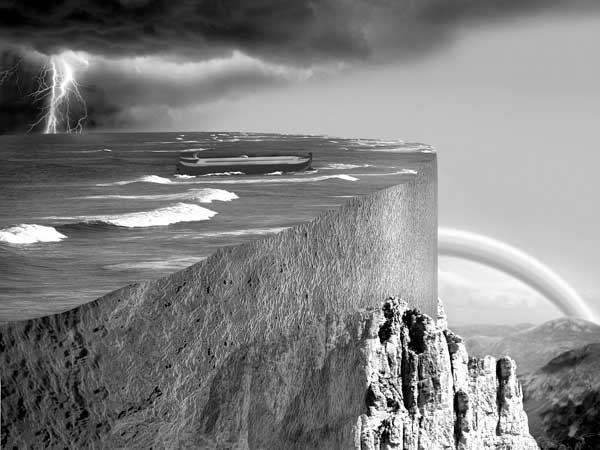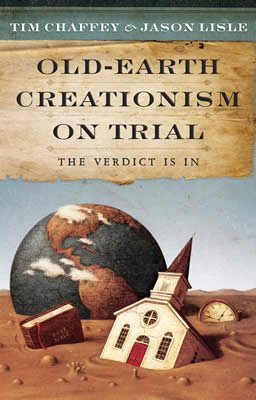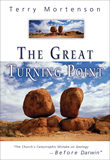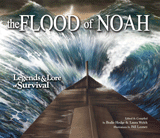
Chapter 5
Prosecution—Extent of the Flood
Often overlooked in the debate between old-earth creationists and young-earth creationists is the biblical account of the Flood. John Ankerberg hosted a debate between young-earthers Ken Ham and Dr. Jason Lisle and old-earthers Dr. Walter Kaiser and Dr. Hugh Ross on the John Ankerberg Show. This debate was filmed in January 2006 and began airing later the same month. Of the ten sessions available on DVD, only a portion of one session was devoted to this topic. This is unfortunate, because the topic of the Flood is inexorably linked with the battle over the days of Genesis.
Young-earth creationists contend that Genesis clearly teaches that the Flood was a worldwide, cataclysmic event. In other words, every single piece of earth throughout the entire world was under water at the same time. The only land-dwelling creatures that survived this Flood were those on board the ark. It is important to understand the extent of the Flood, because many old-earthers use ambiguous language. For example, Dr. Hugh Ross claims to believe in what he calls a “universal” Flood. By this, however, he means that God sent a geographically localized flood that destroyed everything that had come into contact with sinful humans, who at the time (Ross believes) were only living in the Mesopotamian valley (roughly modern-day Iraq). He reasons that there would be no need for God to wipe out Antarctica and its animal inhabitants, because man had not ventured that far yet. These ideas will be examined in chapter 6.
This topic is crucial for another reason. The old-earth creation model accepts secular dating estimates of fossils and rock layers. Hence, old-earth creationists believe that most of the fossils and sedimentary rock layers on earth were laid down over millions of years. However, young-earth geologists have pointed out that a worldwide flood could also account for these features—without the need for millions of years. Certainly, a global flood would kill billions of organisms and trap them in layers of sediment, accounting for the sedimentary rock layers and fossils we see today. So, a global flood means the fossils and rocks are not millions of years old; they are powerful evidence for a young earth. Conversely, if the rocks and fossils really were millions of years old, then there cannot have been a worldwide flood—since such a violent Flood would destroy any previous fossil record. Old-earth creationists therefore must deny a global flood in order for their position to make any sense.
A great deal of research has been done by young-earth creationists confirming that a worldwide flood can account for earth’s amazingly diverse topography. It is beyond the scope of this book to examine all the scientific evidence in this field; nonetheless, several examples are provided in chapter 7. Here, the biblical evidence for a worldwide deluge will be presented.
The worldwide extent of the Genesis flood can easily be established from looking at the text. Numerous verses testify to the total destruction that would come upon the whole earth. Genesis 6–9 provides the historical account of the event so we will start there.
“All Flesh”
In Genesis 6:5, we are informed that man’s wickedness was exceedingly great. As a result, God decided to judge the world to put an end to this wickedness. He said in verse 7, “I will destroy man whom I have created from the face of the earth, both man and beast, creeping thing and birds of the air, for I am sorry that I have made them.
” It is clear that God’s judgment extended from mankind to the birds and land animals.
The fact that all non-marine creatures were wiped out is repeated several times. God said in Genesis 6:13 that it would be “the end of all flesh
” except for those on the ark. A few verses later He qualified this statement by saying that the Flood would “destroy from under heaven all flesh in which is the breath of life; everything that is on the earth shall die
” (v. 17). God said that He would “destroy from the face of the earth all living things that [he had] made
” (Gen. 7:4). Genesis 7:21–23 declares:
And all flesh died that moved on the earth: birds and cattle and beasts and every creeping thing that creeps on the earth, and every man. All in whose nostrils was the breath of the spirit of life, all that was on the dry land, died. So He destroyed all living things which were on the face of the ground: both man and cattle, creeping thing and bird of the air. They were destroyed from the earth. Only Noah and those who were with him in the ark remained alive.
These verses alone should be enough to discredit any notion that the Bible endorses a local flood.
The Size of the Ark
In Genesis 6:15, God instructed Noah to build a huge boat. He said, “The length of the ark shall be three hundred cubits, its width fifty cubits, and its height thirty cubits.
” A cubit is a unit of measure roughly equal to the distance from a person’s elbow to the tip of his middle finger. Scholars believe the standard cubit was 17.5–18 inches. If the 18-inch cubit is correct, then the ark would have been 450 feet long by 75 feet high by 45 feet tall. With these dimensions, the ark would have had a volume of 1.52 million cubit feet.
Why would God tell Noah to build such an enormous boat if He were only going to flood the Mesopotamian region? Noah could have housed all of the local fauna on a much smaller vessel. What is even more perplexing is that God told Noah to build a boat at all if it were just a local flood. Why did God not tell Noah to move instead? We don’t know exactly how long it took Noah to build the ark, but it seems likely that it took many years. This would have been more than enough time to move his family and the animals to a region that was not going to be flooded. In fact, he would have only needed a few weeks or months to walk out of the region.
Dr. Hovind asked Dr. Ross these questions during their debate on the John Ankerberg Show. Ross responded with a highly improbable ad hoc argument which is not found anywhere in the text. He said that it was because “God always provides His preachers a pulpit to preach from.”1 Where does the Bible say that this was the purpose for the ark? This point needs special attention. Noah was told to bring two of every kind of bird on board the ark. Most birds are more than capable of escaping local floods because they have the ability to quickly fly out of the region experiencing the flood. Most land animals could have easily exited the region as well. The idea of a local flood is completely inconsistent with the commands God gave to Noah and makes a subtle attack at God’s nature. Why would God cause Noah to spend years of his life building an enormous and completely unnecessary ark? Moreover, the Bible specifically states that the purpose of putting animals on the ark was to keep them alive (Gen. 7:2–3, 6:19–20).
The Flood Waters
The Bible provides specific details about the Flood itself. At the start of the Flood, we are told that “the fountains of the great deep were broken up, and the windows of heaven were opened
” (Gen. 7:11). The next verse states that it rained for 40 days and 40 nights. In these two verses we are given the sources of the water. The “fountains of the great deep” may be a reference to volcanic and geyser activity. The opening of the “windows of heaven” indicates water from the sky—torrential rainfall.
Genesis 7:18–20 provides some interesting details of the Flood waters.
The waters prevailed and greatly increased on the earth, and the ark moved about on the surface of the waters. And the waters prevailed exceedingly on the earth, and all the high hills under the whole heaven were covered. The waters prevailed fifteen cubits upward, and the mountains were covered.
Notice that even the mountains were covered. Once this occurred, the Flood could not have been a local event. Water will level itself out. Even if the Flood started in just Mesopotamia, it would have gone worldwide as soon as the mountains were covered.

Genesis 8:4 reports that the ark came to rest on “the mountains of Ararat.
” The text does not say that it was specifically on Mt. Ararat. Instead it landed on a mountain in the region of Ararat (eastern Turkey today). However, the point is still the same. The ark landed on a mountaintop. Obviously, the water level was much higher than would ever be obtained by a local flood. Also, it was another two and a half months before the tops of the surrounding mountains were seen (Gen. 8:5). Certainly, the mountain upon which the ark landed was the highest in the region at the time. So, even though the text does not explicitly say it was Mt. Ararat, many scholars believe it is the most likely candidate for the final resting place of Noah’s ark.
Another strong reason for believing that the Flood was global is the duration of the Flood. Many believers have mistakenly assumed that it only lasted 40 days and 40 nights. This is based on a misreading of Genesis 7:12. It is true that the heavy rains lasted this long, but the Flood itself was much longer. Genesis 8:2 seems to indicate that it continued to rain throughout the first 150 days. Perhaps the first 40 days represented the initial downpour and then it continued to rain on a regular basis just as it does today. Bear in mind that the Flood also received water from “the fountains of the great deep.”
The Bible states that the Flood began “in the six hundredth year of Noah’s life, in the second month, the seventeenth day of the month
” (Gen. 7:11). The Flood waters “prevailed on the earth
” for the next 150 days (Gen. 7:24). The waters began to subside and the ark came to rest ten days later (Gen. 8:4). The surface of the ground finally dried up on the first day of the first month of Noah’s six hundred and first year (Gen. 8:13). This was 313 days after the rain began! Noah waited until the 27th day of the second month before disembarking (Gen. 8:14). In total, Noah and his family were on the ark for over a year—371 days to be exact!
The sheer length of the Flood testifies to its global character. No local flood has ever lasted anywhere close to this long. Most local floods only last a few days to a few weeks. It seems preposterous to conclude that the Bible was speaking of something other than a worldwide catastrophe. This brings us to yet another powerful piece of evidence for a global flood.
The Rainbow
Following the Flood, God entered into a covenant with His faithful servant, Noah. As a symbol of that covenant, God provided the rainbow. Pay close attention to the following account from Genesis 9:12–17.
And God said: “This is the sign of the covenant which I make between Me and you, and every living creature that is with you, for perpetual generations: I set My rainbow in the cloud, and it shall be for the sign of the covenant between Me and the earth. It shall be, when I bring a cloud over the earth, that the rainbow shall be seen in the cloud; and I will remember My covenant which is between Me and you and every living creature of all flesh; the waters shall never again become a flood to destroy all flesh. The rainbow shall be in the cloud, and I will look on it to remember the everlasting covenant between God and every living creature of all flesh that is on the earth.” And God said to Noah, “This is the sign of the covenant which I have established between Me and all flesh that is on the earth.”
The rainbow was given as a promise from God that He would never send a flood to “destroy all flesh.” If this were just referring to a local flood, then God has lied every single time someone sees a rainbow in the sky. In this case, He has repeatedly broken His promise, because local floods that kill some animals and people are very common on earth.
Earlier it was mentioned that old-earth theology impugns God’s nature by insisting on millions of years because it necessarily places death before sin. Here again, the old-earthers who argue for a local flood are (inadvertently) attacking the character of our holy Creator by implying that He has lied repeatedly. Many old-earthers may simply be unaware of their serious error in this area and need to carefully examine the grave consequences of accepting such an anti-biblical concept.
Big Changes
So far we have examined some of the obvious arguments for a worldwide flood. Now it is time to look at some subtle evidences for it. The Flood had a tremendous impact on the earth. When Noah stepped off the ark, it would have been a very different environment; the world he knew was gone (see 2 Pet. 3:6). Therefore, God instituted major changes after the Flood. Life on earth was going to be drastically different than it was before the Flood.
When Noah stepped off the ark, it would have been a very different environment; the world he knew was gone.
In Genesis 9:3, God instituted a change in the diets of people. He said, “Every moving thing that lives shall be food for you. I have given you all things, even as the green herbs.
” The “green herbs” is a reference to the original command given to Adam in Genesis 1:29. This verse reveals that mankind was originally only allowed to eat plants. Genesis 1:30 prescribes a vegetarian diet for all of the animals. Since the time of the Flood, man has been allowed to eat meat, but carnivorous activity among the animals may have started soon after Adam and Eve sinned. As far as humanity is concerned, the Flood wrought enormous changes.
The post-Flood landscape would have been vastly different than the pre-Flood world. Many Christians make the mistake of assuming the Garden of Eden existed in the Middle East between the Tigris and Euphrates Rivers. After all, they reason, Genesis 2:14 mentions both of these rivers. The problem with this view is that Genesis 2 says that one river went out of the Garden and then was divided into four rivers, two of which were called the Tigris and Euphrates. The other two rivers were called the Pishon and the Gihon (Gen. 2:10–13). Nothing in the Middle East matches this geographical description. This is problematic for those who believe in a local flood but is what one should expect if the whole world was destroyed by water. Earth’s entire topography would have been completely reworked.
The question naturally arises as to why the Tigris and Euphrates are named as they are. There is an easy explanation for this. After leaving the mountains of Ararat, the post-Flood settlers would have named places and landmarks based on what they already knew. This is the same reason that the United States has places named Birmingham (Alabama), Moscow (Idaho), and Plymouth (Massachusetts), etc. These cities were named after places familiar to emigrants from England, Russia, and elsewhere. It makes perfect sense that those settling the world after the Flood would have done the same thing.
The changed landscape also puts to rest one of the critics’ most common arguments. Dr. Ross often uses this straw-man argument in an attempt to make the global flood look silly. He wrote, “To cover Mount Everest (elevation 29,028 feet, or 8,848 meters) with water would require four and a half times the total water resources of the entire planet.”2 This argument demonstrates Ross’s acceptance of uniformitarian principles.3 He is looking at the present world and assuming that the pre-Flood world was the same, or at least very similar. Young-earth creationists do not believe that Mount Everest existed prior to the Flood. The Bible indicates that at the end of the Flood “the mountains rose, the valleys sank down
” (Ps. 104:8, NASB).
This illustrates a very important principle. When one starts from the Bible, then all of these so-called difficulties can be answered. This makes perfect sense. God is infinite in wisdom and knowledge. He was there throughout history and He told us what happened. Of course His Word should be accurate.
Arguments from Other Books of the Bible
So far we have presented evidence only from the Book of Genesis. Many more arguments could have been given from Genesis but will be covered in the next chapter when responding to local flood arguments. It is now time to examine the evidence provided by the rest of Scripture.
Special Words
The Old Testament uses a particular word to describe the Flood. The word “flood” occurs 39 times in the New King James Version of the Old Testament. Our English word “flood” translates several different Hebrew words. However, whenever the flood of Noah’s day is described, it uses the word mabbuwl (מבול). This word occurs 13 times in the Old Testament, and every time it appears it refers specifically to the Genesis flood.4 The Hebrew language has other words, such as nachal (נחל) or mayim (מים), to describe the kinds of local floods we see today. It is as if the Hebrew writers were making it very clear that the flood of Noah’s day was entirely unique.
The same thing occurs in the New Testament. The Greek language has several words that could properly be interpreted as “flood.” For example, the following words are all rendered as “flood” by the New King James Version: potamos, plemmura, anachusis, and kataklusmos. Of these four words, only kataklusmos (from which we get our word cataclysm) is used to refer to the Genesis flood. Once again, it is as if the Bible writers were setting this Flood apart from any other flood in earth’s history.
The apostle Peter mentioned the Flood in both of his brief letters. In his first epistle, he mentioned that only “eight souls
” were saved during the Flood (1 Pet. 3:20). In his second letter, Peter elaborates on the Flood. He wrote that the original creation was flooded with water and “perished
” (2 Pet. 3:6). Remember, this is one of the three events Peter prophesied that uniformitarian scoffers would “deliberately forget
” (2 Pet. 3:5 (NIV)).
Jumping Ship
Local flood theorists have another severe difficulty to overcome. Many of their old-earth allies have abandoned them when it comes to this topic. For example, some of the leading scholars mentioned in earlier chapters seem to favor a worldwide flood. Dr. Norman Geisler and Dr. Gleason Archer are just two of the many evangelical scholars who have accepted an old earth but apparently do not accept the local flood idea.
Ironically, old-earthers who do believe in a worldwide flood fail to see the inconsistency in their thinking. The idea of billions of years came from the uniformitarian interpretation of the rock layers. Allegedly, it takes a long time for these layers to build up to the point they are today. The inconsistency lies in the fact that a worldwide flood would easily be capable of depositing the sedimentary layers of rock that are observed. The Flood would have also preserved the fossilized remains of countless organisms. So, if there was a worldwide flood, then there is no need for the billions of years. On the other hand, if the fossil record is indeed a record of billions of years of earth history, then a worldwide flood is impossible. The Genesis flood would have reworked the sediments and thus destroyed any alleged record of earth’s ancient past.
In a futile attempt to overcome this difficulty, some old-earthers have proposed a global but tranquil flood. But a global tranquil flood is an oxymoron. Look at the catastrophic effects of local flooding such as the Asian tsunami on December 26, 2004, or the tragic destruction of New Orleans by Hurricane Katrina in August 2005. The eruption of Mount St. Helens in May 1980 also produced tremendous geologic changes in the region as a result of the subsequent flooding, and yet this volcanic eruption was a relatively small one. These were major disasters with extremely tragic results, but they were only local or regional disasters. Try to imagine what a worldwide flood accompanied by “all the fountains of the great deep” bursting forth would do to this world. There simply is no such thing as a tranquil flood, let alone a tranquil worldwide flood.
The Ark as a Type of Christ
One of the interesting aspects of the ark is its comparison to Christ in the New Testament. The ark was literally the only means of physical salvation for all of its occupants. All who failed to board the ark were swept away to destruction. In the same way, Jesus Christ is the only way of salvation (John 14:6). All who fail to trust in Him alone for salvation will be sentenced to everlasting destruction. In a very subtle way, the local flood idea strikes against the concept of Jesus being the only way to the Father. If the Flood had been merely a local event, then every creature outside of the flooded region did not need to board the ark. If this were the case, then one might justifiably wonder if another means of salvation is provided besides the Lord Jesus Christ.
Thankfully, the local flood theorists are not this consistent, at least those who would be considered theological conservatives. They are typically just as adamant as young-earthers that Jesus Christ is the only way to the Father.
The prosecution has made its initial case for the universality and worldwide nature of the Genesis flood. It is time to see if the local flood theorists can successfully answer these arguments and make a legitimate case for their claims.
Old-Earth Creationism on Trial
Opting to skirt the controversy of Genesis as literal history, the biblical authority of the Holy Word is called into question and reduced to a collection of mere stories.
Read Online Buy BookFootnotes
- Dr. Hugh Ross, “The Age of the Earth” on the John Ankerberg Show, October 2000.
- Ross, The Genesis Question, p. 148.
- The acceptance of uniformitarian principles is responsible for many of the scientific mistakes made by old-earth creationists. Chapter 8 deals with these kinds of arguments.
- See Genesis 6:17; 7:6, 7, 10, 17; 9:11, 15, 28; 10:1, 32; 11:10; and Psalm 29:10.
Recommended Resources

Answers in Genesis is an apologetics ministry, dedicated to helping Christians defend their faith and proclaim the good news of Jesus Christ.
- Customer Service 800.778.3390
- © 2024 Answers in Genesis




